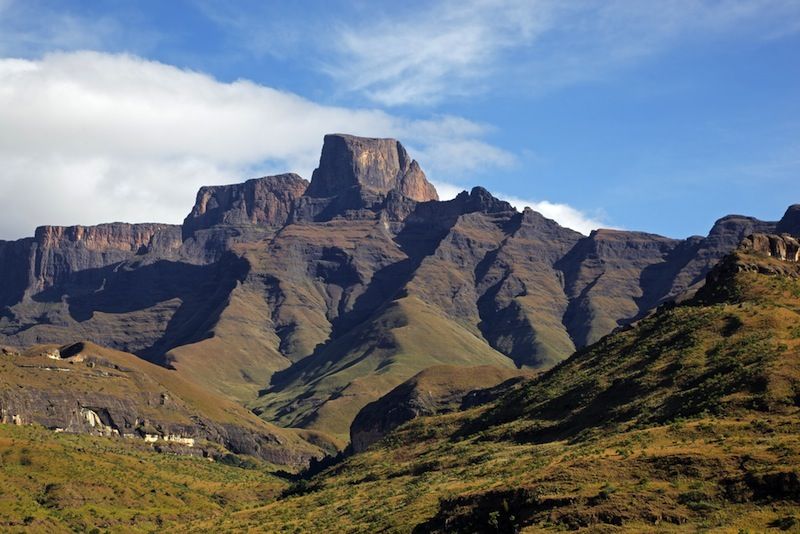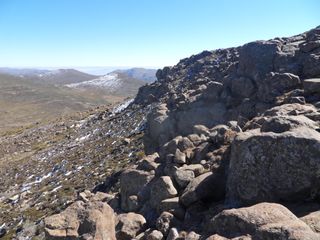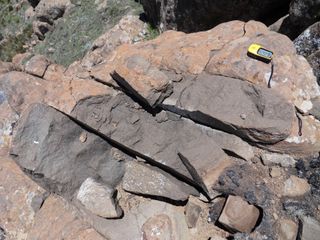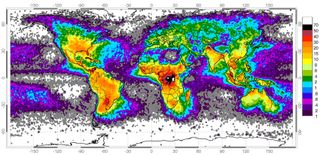
Electrocution: New Way to Erode Mountains

Boom, zap, pow! Who needs superheroes to move mountains, when lighting does the job just fine?
Powerful explosions sparked by lightning create piles of angular, jumbled rocks atop mountain summits, a new study shows. The frequent blasts break down high peaks more quickly than frost-shattering — when freezing water wedges apart fractured rock.
In Lesotho's Drakensberg mountains, a single lightning bolt can blow out 100 to 350 cubic feet (3 to 10 cubic meters) of bedrock, said Jasper Knight, lead study author and a geomorphologist at Wits University in South Africa. The sheer volume of summer lightning strikes atop high peaks, combined with their massive erosive power, means electric blasts are a long-overlooked force in bringing down mountains, Knight and his co-author conclude.
"Lightning is very significant in causing landscape erosion and the formation of lots of fractured bedrock," Knight told LiveScience's OurAmazingPlanet. "What I think this project does, in highlighting the role of lightning, is go some way toward overturning a very entrenched and long-held paradigm of how many continental scale landscapes have evolved." [Electric Earth: Stunning Images of Lightning]
The findings were published Aug. 7 in the journal Geomorphology.
Dynamic force

Bare peaks above 10,000 feet (3,050 meters) tend to fall down very, very slowly, over hundreds of thousands of years, or so the thinking goes. The leisurely breakdown takes place primarily by water melting and freezing inside cracks, which breaks rocks into pieces. Examples of mountains eroding this way in the United States include the Wind River Range, the Sierra Nevada and the Rocky Mountains.
Sign up for the Live Science daily newsletter now
Get the world’s most fascinating discoveries delivered straight to your inbox.
"Often people studying these regions have assumed they are just sitting there, they're not changing very much," Knight said. "Our study shows that we can have quite dramatic changes over the time scale of a single lightning strike. These mountains are far more dynamic, and changing far more quickly, than we realized."
While the study is the first to quantify lightning-caused erosion, geologists have traded stories of rocks hit by lightning strikes for nearly a century, Knight said. The evidence is anecdotal but obvious: Lichen seared off rocks, freshly fractured surfaces, boulders blown out of place and, in some cases, the fierce heat creates a thin, melted crust called fulgurite.

Geomorphologist Bob Anderson, who was not involved in the study, said he saw lightning carve a trench 165 feet (50 meters) long and 4 inches (10 centimeters) deep into soil while hiking in the Colorado Front Range in 1969. The same lightning strike killed 11 sheep, tossing them 6 feet (2 m) in the air, said Anderson, of the University of Colorado at Boulder.
"One thing I've seen on summits in the West is a boulder whose original site was a meter [3 feet] away from where the block rests on the surface, a flat bedrock surface. There's no other surface process [than lightning] that we know of that could do that. If you find something blasted out of the middle of an outcrop, that's pretty diagnostic," Anderson said.
A lightning strike lasts less than a second. And in summer, when thunderstorms roll in every afternoon in the mountains, some spots get more than 30 or more hits per square kilometer, according to satellite tracking data.

Lightning's intense heat, around 54,000 degrees Fahrenheit (30,000 degrees Celsius), also resets a rock's magnetic minerals. When rocks form, magnetic minerals align toward magnetic north. Lightning realigns the grains toward the current pole. (The magnetic pole wanders and flips north and south fairly often, geologically speaking.) Up close, the effect wreaks havoc with compasses.
Tracking lightning
Knight and Wits University colleague Stefan Grab relied on their eyes and their compasses to track down lightning-blasted rocks in Lesotho's Drakensberg mountains, the highest mountains in southern Africa. Basalt rocks here are lava that cooled 180 million years ago, when Africa was rifting from the Gondwana supercontinent. The basalt's ancient magnetic alignment is quite different than the new direction set by lightning strikes. The pair mapped lightning strikes and estimated the volume of debris created by the blast.
"When we get close to the precise location of the lightning strike our compass begins to swing," Knight said. "Sometimes it swings very quickly through 360 degrees."
Despite its spectacular effects, lightning's role in destroying mountains is likely limited to bare rock settings, such as high mountaintops. At lower elevations, trees and soils (or sheep) absorb the energy. [Infographic: Tallest Mountain to Deepest Ocean Trench]
"This is a good first step in showing us that there are certain kinds of geomorphic settings in which this might be a significant process," said Anderson, who thinks lightning is a factor in forming granite tors (large, free-standing rock formations) in the Colorado Front Range and the Wind Rivers. "That ought to wake people to look around and not just swallow whole the notion that all the cracked up rock in these high surfaces is frost-shattering," he said.
Email Becky Oskin or follow her @beckyoskin. Follow us @OAPlanet, Facebook & Google+. Original article on LiveScience's OurAmazingPlanet.












